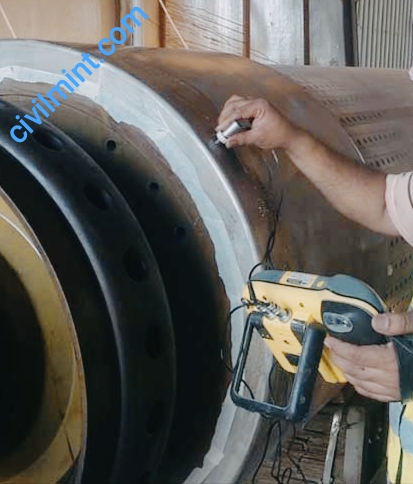Table of Contents
What is Nondestructive Testing?
Nondestructive testing is a techniques in which inspection and testing of a material is done without causing damage. This technology is helpful to save time and money.

As there is no damage to inspected material, the material can still be in operating condition. NDT is very environmental friendly because there is no pollution due to material inspection and testing. Nowadays NDT become very popular. Nondestructive testing almost used in every engineering field.
The internal structure of the material can be easily detected by using X-ray and Gamma ray.
The quality inspection by using NDT helps to evaluate actual strength of the material.
Modern non-destructive testing is used in manufacturing, production, and routine inspections to ensure product integrity and reliability, control the manufacturing process, reduce manufacturing costs, and maintain consistent quality levels.
During construction, NDT is used to ensure the quality of materials and joining processes during manufacturing and assembly, and in-service NDT inspection is used to ensure that products in use maintain their integrity.
Difference Between Destructive and Nondestructive Testing?
Destructive testing destroys or alters the part in some way so that even if the part passes the test, it is no longer fit for use. Such example of destructive test is compressive strength test of concrete. While, NDT does not destroy or modify parts in a way that makes them useless after they pass testing.
Advantages of Nondestructive Testing
There are some distinct advantages, but the most obvious is that the parts being inspected are not damaged throughout the process, so if something goes wrong, the item can be repaired rather than replaced.
It is also a very safe test method for operators as most of the techniques are harmless to humans, but some types of tests such as X-ray inspection must still be performed under severe conditions. This testing methodology also helps prevent injury and death by ensuring the safety of structures, components and machinery.
These test methods are also economical. Unlike destructive testing, NDT is cost effective because it does not destroy the part itself, eliminating the need to replace parts before they malfunction.
This testing methodology also allows operators to ensure that equipment is functioning properly and to determine measures to prevent future accidents and extend its life.
Applications of NDT
NDT is used in a variety of settings covering a wide range of industrial activities, and new NDT methods and applications are constantly being developed. Non-destructive testing methods are routinely used in industries where component failure causes serious hazards and economic losses such as Vehicles, pressure vessels, structures, pipelines, and lifting equipments.
Welds may be tested using NDT techniques such as industrial radiography or industrial CT scanning using X-rays or gamma rays, ultrasonic testing, liquid penetrant testing, magnetic particle inspection or via eddy current. In a proper weld, these tests would indicate a lack of cracks in the radiograph, show clear passage of sound through the weld and back, or indicate a clear surface without penetrant captured in cracks.
Structure can be complex systems that undergo different loads during their lifetime, e.g. Lithium-ion batteries. Some complex structures, such as the turbo machinery in a liquid-fuel rocket, can also cost millions of dollars. Engineers typically model these structures as second-order coupled systems by approximating the dynamic structural components with springs, masses, and dampers. The resulting set of differential equations is then used to derive a transfer function that models the behavior of the system.
In non-destructive testing, structures receive dynamic inputs such as hammer or controlled pulse tapping. As corresponding outputs, key properties such as displacement and acceleration are measured at various points of the structure. This output is recorded and compared with the corresponding output given by the transfer function and the known input.
Several NDT methods are relevant for clinical procedures such as Radiography, ultrasound, visual inspection. Technical improvements or upgrades to these NDT methods have been inherited from advances in medical devices such as digital radiography (DR), phased array ultrasonography (PAUT), and endoscopy.
